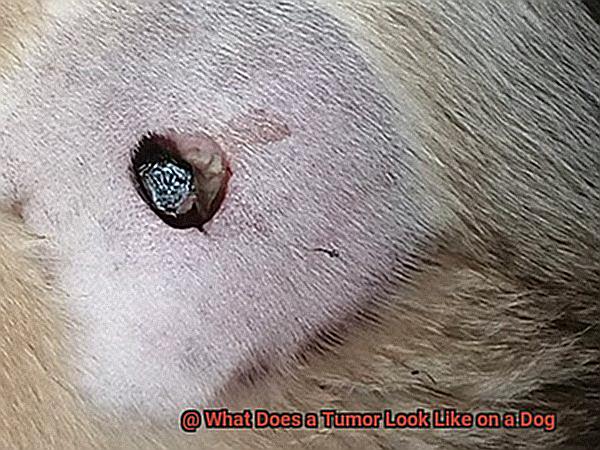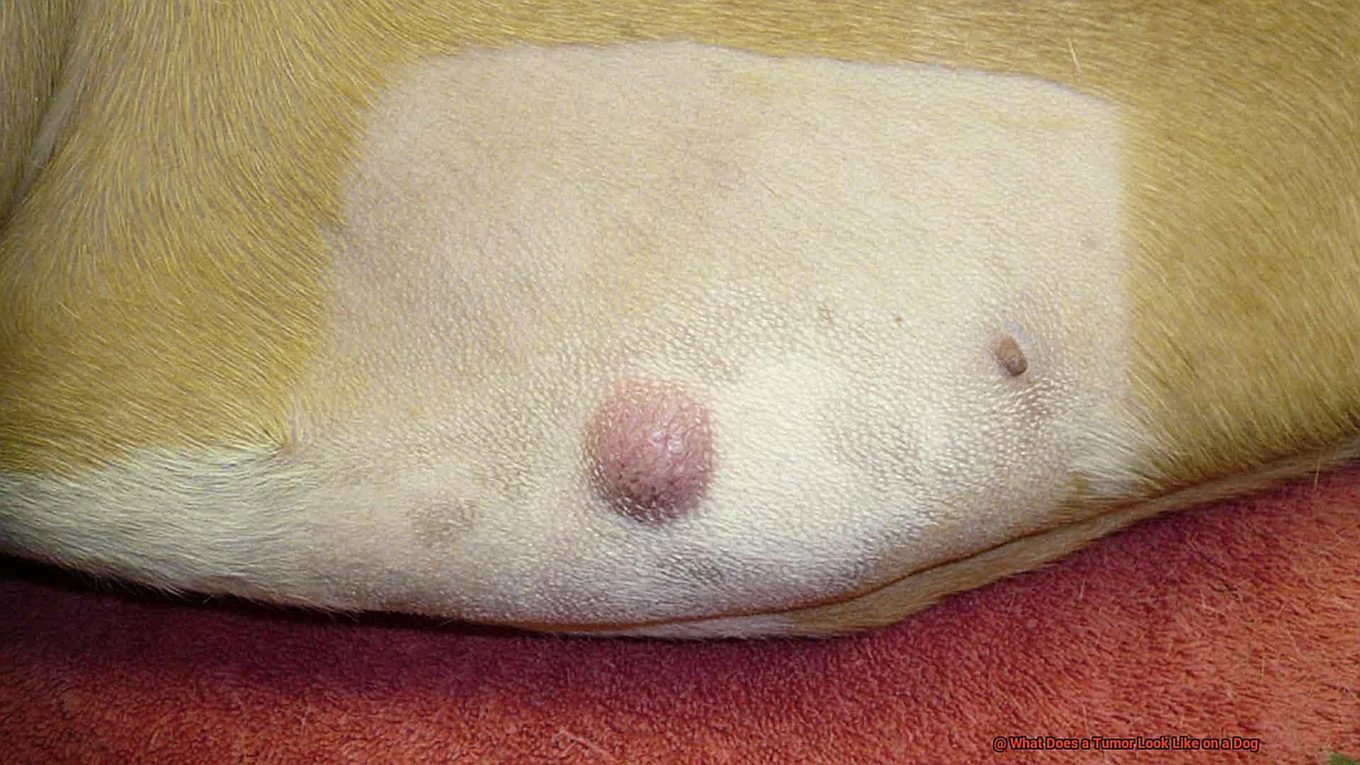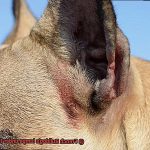What Does a Tumor Look Like on a Dog?
Finding a tumor on your beloved dog can be every pet owner’s worst nightmare. But what does a tumor look like on a dog? It’s not always easy to tell, but there are some key signs to watch out for.
Tumors come in all shapes and sizes, and can affect any part of the body. They can be benign (non-cancerous) or malignant (cancerous). Benign tumors are typically slow-growing and don’t spread to other areas, while malignant tumors can spread quickly and become life-threatening if not treated right away.
If you suspect your dog has a tumor, there are several telltale signs you should look out for. A lump or bump is one of the most common signs that something is wrong.
It can appear anywhere on your dog’s body, from the head to the paws, and it can be hard or soft depending on the species.
In addition, tumors may cause discoloration in the area where they’re located, as well as itching or pain if they’re close to nerve endings.
If you find anything unusual about your pup, it’s important to seek help from a specialist right away. Early detection is key when it comes to treating tumors in dogs.
What is Cancer?
Contents
Cancer is a devastating disease that affects people of all ages and backgrounds. It is a group of disorders characterized by abnormal cell growth that can occur in any part of the body. Changes in the DNA of cells are responsible for cancer, and it can spread to other areas of the body through the lymphatic system or blood stream.
If you suspect you have cancer, there are some common signs and symptoms to look out for, such as fatigue, weight loss, pain, and difficulty breathing. If any of these are present, it’s important to see your doctor as soon as possible for a diagnosis. This is usually done through imaging tests like X-rays, CT scans, and MRI scans.

Once a diagnosis has been made, there are several treatment options available to help manage cancer. These include surgery, chemotherapy, radiation therapy, immunotherapy, and targeted therapy. Your doctor will be able to discuss these options with you and determine the best course of action for your unique situation.
Can Dogs Get Skin Cancer?
In fact, there are three main types of skin cancer in dogs: squamous cell carcinoma, mast cell tumors, and melanoma. These types of cancer may develop on the skin or inside the body.
Squamous cell carcinoma is the most common type of skin cancer in dogs. It usually presents as a lump or bump on the skin.
Mast cell tumors are typically seen as lumps or bumps that may be red and/or ulcerated. Melanoma is usually dark in color and may look like a mole or wart on the skin.
Dogs with lighter fur are more prone to developing skin cancer than those with darker fur. Sun exposure can also increase the risk of skin cancer in dogs, so it’s essential to keep your pet out of direct sunlight for extended periods of time.
If you think your pup has any signs of skin cancer, it’s vital to take them for an examination and diagnosis right away.
What Does a Tumor Look Like on a Dog?
Tumors in dogs come in all shapes, sizes, and locations. Knowing the common signs and symptoms of tumors in dogs is essential for diagnosing them accurately.
Start by looking for lumps or bumps on the skin. These can appear anywhere on the body, so it’s important to do regular check-ups and feel your pup for any changes. Additionally, watch out for discoloration of the skin, swelling of the area around the tumor, and changes in fur texture.
It’s worth noting that not all tumors are cancerous; some may be benign (non-cancerous) growths. However, it is still important to have any lump or bump checked by a vet as soon as possible to rule out any underlying medical conditions.
When examining a dog’s skin, take note of any changes in size, shape, color, or texture that occur over time. If the tumor appears to be growing rapidly or has an irregular shape or border, this could indicate cancer and should be examined by a veterinarian immediately.
Finally, keep an eye out for any other changes in your dog’s behavior, such as lethargy or loss of appetite, as these can also point towards underlying medical issues such as cancer.
Causes of Skin Cancer in Dogs
Skin cancer in dogs is a concerning issue for many pet owners. But what causes it? Genetics, age, lifestyle, and environment can all play a role in the development of skin cancer in dogs.
Certain breeds are more prone to developing skin cancer than others. Older dogs are also at greater risk than younger ones.
Additionally, lifestyle plays an important role: dogs that spend a lot of time outdoors may be exposed to damaging UV rays from the sun. Living in areas with high air pollution or near industrial sites can also increase the risk of skin cancer due to exposure to toxins in the air.
Other potential causes of skin cancer include hormonal imbalances, poor nutrition, and certain medications. It’s important for pet owners to be aware of these risks and take steps to protect their dogs from developing skin cancer.
Difference between Tumors, Growths, and Cysts
As a pet parent, it’s important to know the difference between tumors, growths, and cysts to identify them on your dog’s body. Tumors are abnormal cell growths that can be either benign or malignant.
They range in size from a few millimeters to several centimeters in diameter and may have an irregular shape.
Malignant tumors are cancerous and can spread to other parts of the body, while benign tumors are non-cancerous and typically do not spread.
Growths usually appear as a lump or bump on the skin and feel firm when touched. They can be caused by infection, inflammation, or injury.
Cysts are fluid-filled sacs that form in any part of the body, and they may contain a whitish fluid inside when opened up.
They are usually harmless, but if they become infected, they may need to be drained or surgically removed.
It’s essential to keep an eye out for these physical changes so you can get your pup checked out by a vet if necessary.
Diagnosis
It’s important to visit a veterinarian as soon as possible. Skin cancer in dogs can be diagnosed with physical examinations and laboratory tests such as biopsies or imaging scans.
The vet will carefully inspect the skin tumor, feeling for any bumps or lumps, looking for any changes in color or texture, and examining the lymph nodes for any swelling. If the vet suspects that the tumor is cancerous, they may recommend taking a biopsy of the tissue to determine if it is malignant.
Imaging scans such as X-rays and ultrasounds can also be used to help diagnose skin cancer by identifying abnormal growths or tumors.
Only after these tests are performed can an accurate diagnosis of skin cancer in dogs be made.
Also Read: Why is My French Bulldog Limping?
Conclusion
Discovering a tumor on your beloved dog is a pet parent’s worst nightmare. So, what does a tumor look like on a dog? It could appear as lumps or bumps, discoloration of the skin, swelling of the area around the tumor, itching, or pain if it’s close to nerve endings.
Early detection is key for accurate diagnosis and treatment, so don’t hesitate to seek advice from a specialist if you notice any changes in your pup.
Skin cancer is another worrying problem that many dog owners face. Genetics, age, lifestyle, and environmental factors are all potential contributors to its development.
To protect your pup from this disease, it’s important to be aware of these risks and take steps to shield them from harm. Diagnosis usually involves physical examinations and laboratory procedures such as biopsies or imaging scans.
Tumors, tumors, and cysts can all affect dogs but they are not always easy to spot without help from professionals. Knowing the common signs and symptoms of each disorder helps diagnose them quickly and get your dog the care they need.
If you notice any changes in behavior such as lethargy or appetite loss – make sure you contact your vet immediately for further examination.
To sum up: Pet owners must remain vigilant about their furry friend’s wellbeing by doing regular check-ups and looking out for any unusual signs or symptoms that could point to underlying medical conditions such as cancer.




